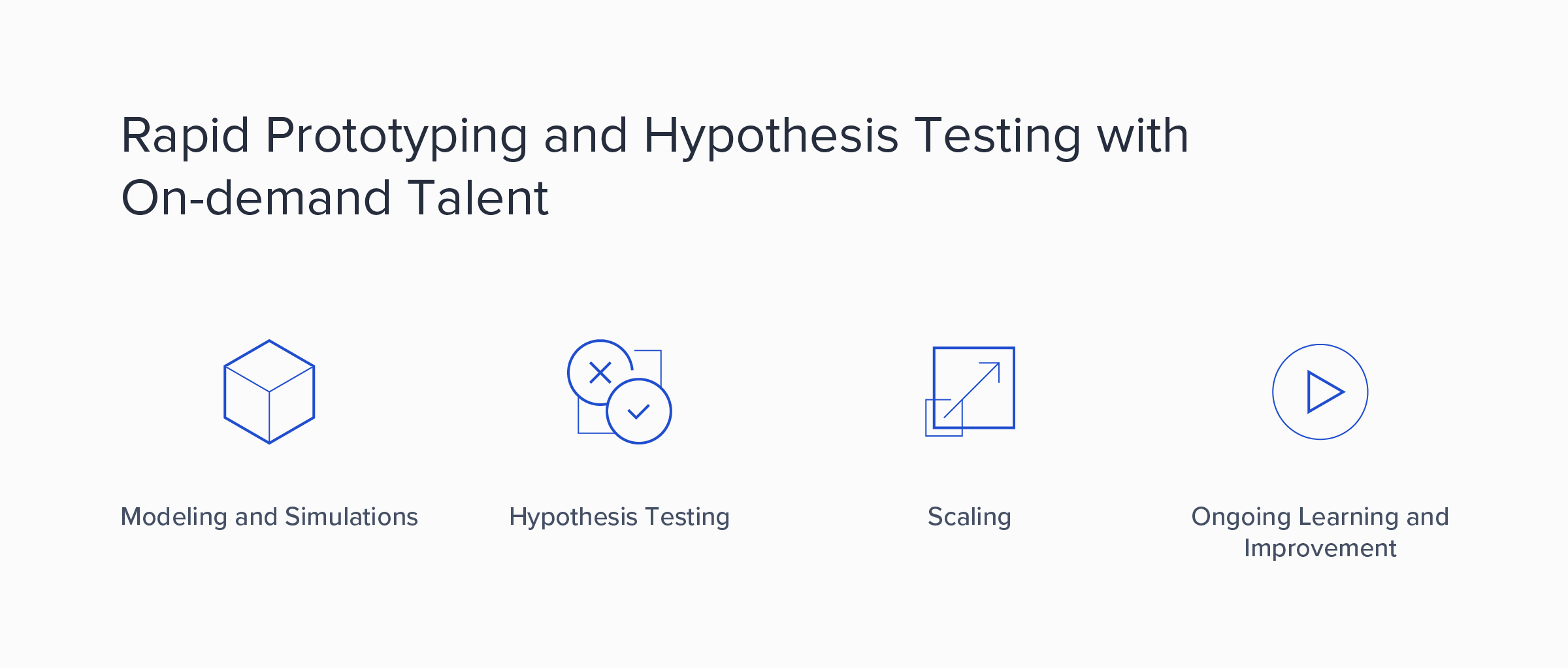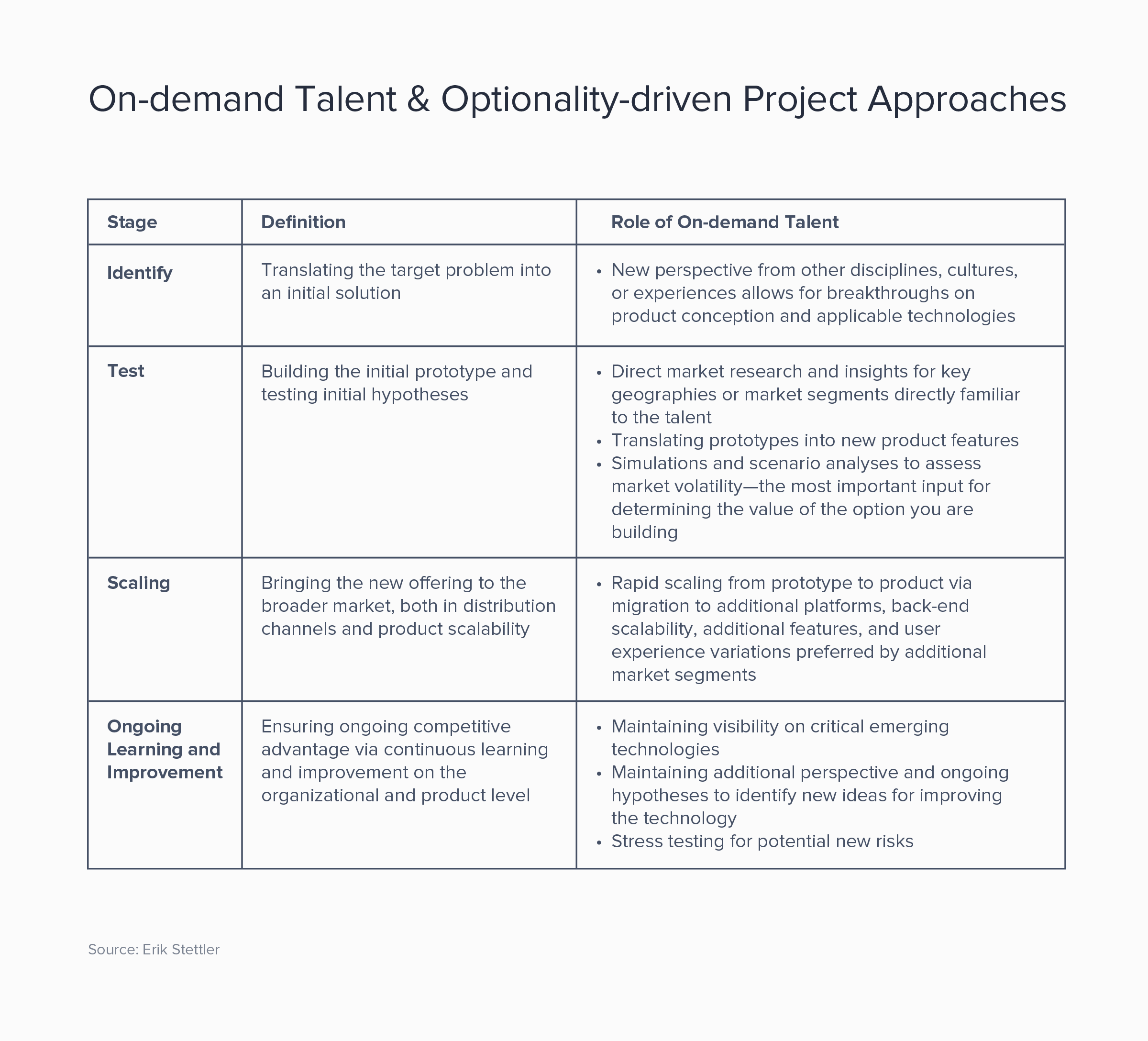The Power of Optionality: Volatility to Opportunity With Distributed Teams
authors are vetted experts in their fields and write on topics in which they are extremely knowledgeable. All of our content is peer reviewed and validated by world-class professionals.

Extreme changes in technology and the global talent economy necessitate a new way of approaching risk and reward—optionality. Optionality involves positioning yourself to have the ability (but not the obligation) to take critical actions such as launching a new product or transforming your business model.
Today, optionality is even more crucial as we confront the economic dislocation and immobility due to COVID-19. The extreme change brought about by this crisis amplifies the technology and talent-driven changes that we explored previously, as remote work and the need for digital and adaptable business strategies become paramount. In this article, I discuss how to identify options, rapidly test hypotheses and prototypes, scale options, and create ongoing learning for your organization. I'll also explain how the new reality of remote work and on-demand talent can facilitate these processes.
Planning Optionality-driven Projects
An optionality-driven approach to high-tech projects using globally distributed teams is a departure from standard project planning. Options-driven project planning begins by philosophically embracing volatility in markets and technology rather than bunkering down against it. This model adopts operational flexibility, continuous experimentation, and hypothesis testing as a standard process. Scenario analysis takes priority over point-prediction, and a high initial failure rate is acceptable due to the outsized returns from successes.
This asymmetric payoff structure—limited downside and unlimited upside—has been understood to be tremendously valuable for a long time. The rise of global on-demand talent now allows businesses to make it far more central to their growth strategies.
Identifying the Right Options
In a subsequent piece, I'll explore processes for envisioning new products and markets in the context of extreme volatility. Here, I offer two initial thoughts from my own experience.
First, the most successful initiatives I've witnessed have all come from problem-driven approaches, rather than idea-driven ones. Begin with the end goal. Think in terms of problems that you've encountered or that you've witnessed with your customers or other stakeholders—only then ask how technology can help. This strategy is more critical in the context of COVID-19 than ever. Customers will be slow to purchase "nice to haves" but will still be willing to pay for solutions to the real problems they are facing, both those that preceded COVID-19 and those brought about by the crisis.
Second, the decision rule most conducive to survival does not involve predicting the correct action—it's about knowing in which direction you can afford to be wrong. If you sense the possibility of technology transforming your industry, then the consequences of avoiding action far outweigh those of taking steps that prove unnecessary. This decision rule will become more critical as the world becomes more volatile.
How to Prototype and Test Hypotheses with On-demand Talent

Once you have the initial solution in mind, the focus turns to market and technological validation via the most economical and flexible means possible. Speed and agility are especially crucial in this formative stage, and the ability to rapidly expand your team across multiple dimensions—areas of expertise, geographical reach, and overall productive bandwidth—can make the difference in beating competitors to market.
Diversity Is Innovative Strength
Diversity of experience, profession, and perspective is one of the greatest strengths an organization can foster. The power of diverse teams is nonpareil, and removing location bias facilitates opportunity. For example, in a study published in Economic Geography, the data showed that diverse leadership most often resulted in innovative products, compared to companies with homogenous leadership.
Instant access to remote experts—through platforms like Toptal and BTG—is invaluable, whereas hiring them full-time would be cost-prohibitive and unnecessary. I have personally experienced breakthroughs due to the simple act of explaining a problem to a knowledgeable new party—you end up hearing what you've been trying to say all along. A personal example: While working in the context of market crises, biologists were able to frame the dangers of the subprime crisis through the models of collapsing ecosystems.
On-demand experts with geographical or sector-specific knowledge allow you to validate new markets directly. These expert platforms do for knowledge and experience what Google did for information. I have seen many companies completely revamp their thinking and planning after one discussion with a specialized, culture-specific expert. I have also witnessed many brilliant teams from the US and Europe attempt to launch a new venture in Latin America (where I split my time) with very finely tuned business models. Many did not realize that the majority of their underlying assumptions—logistics, culture, and even security—were invalid. A brief consultation with localized business experts was the difference between timely adjustments and tremendously painful failures.
The most valuable currency is information, rather than revenue, which will remain the case for a very long time (data is the new gold). The cyclical process of optionality requires asking what hypotheses need to be validated (to further de-risk the project), applying the most promising new technologies toward testing them, analyzing the results, and incorporating the results into the next hypothesis.
The different project stages of an optionality approach can be understood as follows. In each case, I include the key ways global on-demand talent can boost efforts.

Test (Modeling and Simulations)
As previously noted, market forecasting during this stage is less concerned with predicting specific outcomes than with the distribution of potential ones. Monte Carlo simulations are a highly useful tool for this aim. Even with full-time data scientists on staff, it's valuable to augment your team through additional outside support since these analyses aim to capture the effects of randomness and unexpected circumstances in market evolution. An outside expert’s perspective may identify other change drivers that your full-time staff may miss due to their exposure to organizational assumptions. (This is not a comment on ability at all; we all adopt our assumptions and blind spots and need outside perspective to challenge them.)
A final area of highly technical analysis at this stage is full real options modeling, which is a specific type of project valuation that assigns an actual dollar value to the option you're building. This analysis provides a quantitative and visual map that demonstrates critical decision points and potential outcomes—it provides a financial roadmap, rather than just a valuation estimate. Full real options modeling is a valuable exercise but not a prerequisite for following this framework. So long as you recognize the extreme change in talent and technology as a source of opportunity and adopt this hypothesis and scenario-driven approach, don't fret if time or budget does not allow for a full-blown real options analysis.
Scaling
Once you've decided to move forward, you'll need to deploy resources for technological scaling, marketing, and logistics while maintaining a firm sense of the unfolding financial reality. Scaling brings its own set of challenges and often requires diametrically opposite approaches and skills than initial validation.
Scaling is the stage at which many promising startups and corporate initiatives fail, and its challenges are compounded by how it requires highly contrasting approaches and principles vs. initial prototyping and validation. Calling upon on-demand talent can inject additional capacity and know-how, executing scaling conclusively with fewer long-term costs. Industrial and manufacturing companies have long since realized the immense value of flexible supply chains in the face of rapidly changing markets. In essence, on-demand talent offers the same saving grace in terms of knowledge and technological scaling capacity.
The many ways in which your product will require technological scaling (and where on-demand talent can be integral) include:
- Migration to additional platforms (iOS, Android, web, etc.)
- User experience adjustments for new markets in terms of (human) language, design preferences, and local regulations or technologies
- The scalability of the technological infrastructure itself. The prototyping and validation stage called for the most rapid and low-cost means of obtaining market feedback, rather than the most robust systems architecture. Now, you need to prepare for the influx of more users while keeping the product running smoothly for current ones.
- Advanced features for key clients. These requests are always a delicate matter for young companies. Landing your first large clients is thrilling but often brings requests for more advanced features that may be more specific to their needs than those of your general market. You don't want to upset or lose these accounts, but you also can't allow one company's needs to dictate your overall product roadmap.
All of these steps require additional expertise both in quantity and often in focus areas, and many of them need a significant initial push to get things running. In the case of specific features for flagship clients, the work can likewise be siphoned into projects that can be completed by on-demand talent in parallel with your full-time team's ongoing work. Introducing fresh, critical insight into the organization is vital at this step. The organization will need to learn and adapt to be successful, and knowledge is crucial to these efforts.
Ongoing Learning and Improvement
The moment you declare victory for a new product—or, even worse, your overall ability to stay ahead of the game—can be the most dangerous. This danger is magnified by how little it feels as such. In the earlier stages, we were at least fully cognizant of the challenges we were facing. Never be satisfied with your product and market presence in their current states. Be fearful when profits are massive. Remember that the forces of change that brought you this victory will continue to evolve beyond this moment.
Continue to test hypotheses and identify ways to increase your product's scope and sophistication, and conduct regular stress tests to challenge your assumptions and identify new pockets of risk. On-demand talent with fresh perspectives adjacent to your industry can be especially valuable for these ongoing challenges and periodic stress tests. Many times, new clients in this situation have specifically charged me with challenging as many of their assumptions as possible, and I’ve likewise made a habit of mentioning up front that, if I never upset them, I’ve probably failed them.
Several of the most successful entrepreneurs and product managers I know make a habit of brainstorming and even prototyping from the point of view of a scrappy new competitor to themselves. This forces uncomfortable conversations about where they need to pivot strategies or improve. They purposefully conduct these exercises when everything seems to be going wonderfully in terms of growth—they realize that these moments risk complacency because it’s the moment that others may be most enticed to compete with you. These exercises often involve blended teams to source external viewpoints. I have witnessed several creative and technological breakthroughs come out of these exercises.
When running project teams and companies, long-term planning is essential. However, the magnitude of change brought by technology, the talent economy, and now the economic disruptions from COVID-19 make it more critical than ever to embrace agile experimentation. The global on-demand talent pool and the optionality framework for project planning and valuation—which some of the greatest analytical minds have been developing for decades—open up new possibilities for this approach that previous generations of managers could have only dreamed of.
The profound changes in talent, technology, and now the global economy are risks only if we accept them as such. Optionality is the one strategy that gains value from volatility. By adopting this mindset and approach, the question won’t concern how you will be affected by change, but what you can achieve because of it.
